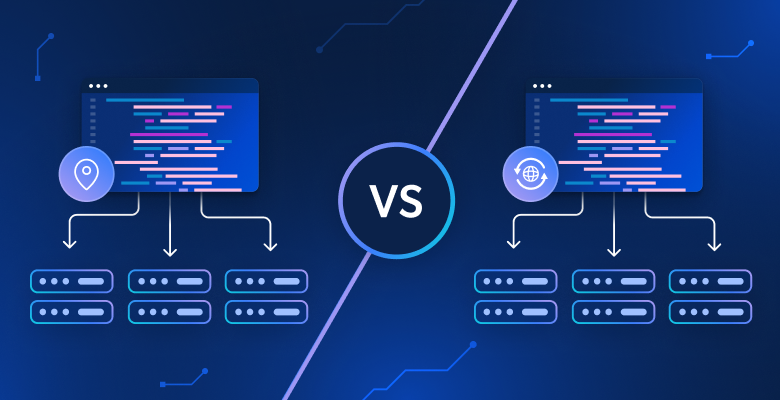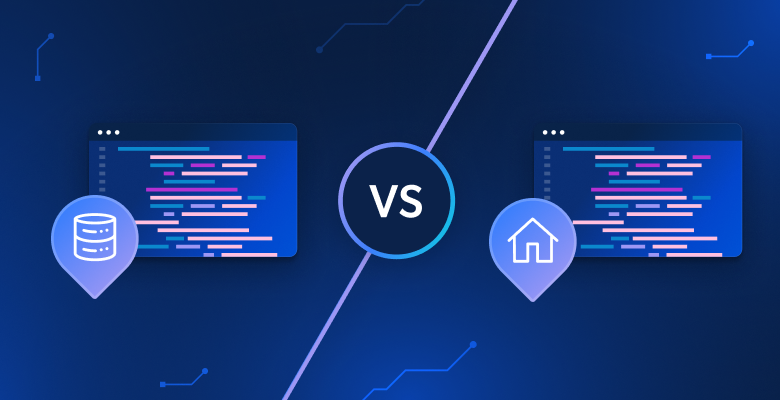In this post we will cover:
- What is a regular proxy (forward proxy)?
- What is a reverse proxy?
- Which one should I use for my business?
- Examples of use cases using forward and reverse proxies
- Proxy alternatives that help get the job done
What is a regular proxy (forward proxy)?
“Forward” or “classic” proxies are used to send requests from a user to a target site through a server. Forward proxies initially check to see if requests are valid; in a scenario where they aren’t, the client will receive an “error” or “redirect” notification. The cached information will be processed right away, while requests that aren’t cached will be sent to content servers through a firewall. The information will then be sent back to the first person who asked for it and cached for future use.

What is a reverse proxy?
A reverse proxy is a way in which proxy traffic can be structured in an attempt to add an additional layer of protection to an internal pool of data that lives on a private/isolated network. It does this by transferring requests first through a firewall and then to the first server (A), which, unbeknownst to the requester, is transferred to the second server (B), which actually possesses the target information in question. Then, Server A stores (caches) the data so that when similar requests come up in the future, there will be less network traffic.

There are other types of proxies as well. If you are interested in expanding your horizons, check out our post on ‘SOCKS4/5 VS HTTP proxies’ and learn more about end-to-end HTTP tunneling methodologies.
Which one should I use for my business?
It depends on your business and its particular needs. Forward proxies are great for simple, straightforward content requests, like getting government records from a digital archive (more on this example in the next section).
A reverse proxy could be more useful to a company that generates data independently. They might want to keep some of that data open to the public, while other sections may contain highly classified, proprietary data pertaining to the essence of their technology (more on this in the next section).
Examples of use cases using forward and reverse proxies
Now that you know the main differences between both of these proxy archetypes, let’s expand on each of the above examples to help illustrate how/when each of these can be best utilized:
Forward proxy use case
An insurance provider may want to gain access to publicly available government archives. This could be an attempt to feed algorithms past data in order to train their artificial intelligence (AI) to develop actuarial capabilities based on historic occurrences. This is a straightforward data collection job, and as such, a forward proxy would be a perfect choice.
Reverse proxy use case
The above example discussed a company that had public-facing data while simultaneously having private data. This may occur for a bunch of reasons. For instance, a company’s internal network might be linked to their public website or the internet as a whole. By using a reverse proxy, they cut themselves off from competitors and/or bad actors who want to hurt or steal data assets.
Other popular reverse proxy use cases include:
- Using a reverse proxy to conceal information pertaining to your core operational servers in order to help increase cybersecurity and help avoid cyber attacks. This can be a part of a larger network security strategy that includes network segmentation, i.e., the division of non-crucial assets from important operating systems.
- Large websites with high volumes of traffic may want to make use of reverse proxy servers in order to divide the load on their servers more evenly. In this context, Bright Data wrote an in-depth analysis of the Fastly load balancing incident in which we discussed how ‘by dividing a load up among millions of peers, companies are essentially able to create a network that doesn’t depend on any specific server, ensuring that networks are constantly operational. This also solves potential latency issues due to a target site’s location, by making use of peers or super proxies from nearby locations.’
Proxy alternatives that help get the job done
Forward and reverse proxies take a lot of time and effort to build and integrate into a company’s operational flow. Many of them are unaware that there are alternatives, at least when it comes to using forward proxies for data gathering.
Companies that choose to use a third-party data collection network like Bright Data enjoy some major advantages:
- Their internal networks are completely separate from their data collection efforts.
- Datasets delivered to them use end-to-end encryption, ensuring that information is only seen by authorized parties.
- A massive global peer/super proxy network ensures quick collection speeds as well as the capacity for unlimited concurrent requests.
- Web assets that are concerned with inbound traffic can opt to integrate one of Bright Data’s main four proxy services into the architecture of their systems/websites. This can help create the desired buffer zone between one’s proprietary cloud data and open-source information. This is achieved by leveraging millions of peer devices located across the globe as well as IP rotation techniques, all while using a complex data routing structure and end-to-end encryption, making it nearly impossible for malicious actors to breach.
The bottom line
Depending on your business’s target data as well as the data lakes that could be potentially at risk, one should go ahead and choose the type of proxy solution that is right for his or her business. Simple, straightforward requests can work perfectly using a “classic proxy”, while companies that have internal or external-facing data may want to use a reverse proxy. Companies that want to collect data in different ways and keep it as safe as possible in the cloud may also choose to use a third-party technology or solution that takes on this responsibility and creates a safety barrier.








